The Business Case for Electronic Health Records (EHR) Investment
VerifiedAdded on 2021/06/14
|24
|5279
|31
Report
AI Summary
This report presents a comprehensive business case analysis for investing in Electronic Health Records (EHR) within a doctor's practice. It begins with background information on the healthcare landscape in Australia and the challenges faced by general practices, followed by an explanation of EHR systems and vendors. An executive summary highlights the report's key findings and recommendations, which emphasize the importance of EHR implementation for improving healthcare quality and reducing costs. The report then delves into the strategic context, including a SWOT analysis of EHR implementation and a discussion of the mission statement and business process model. The core of the analysis evaluates the investment using Net Present Value (NPV), Return on Investment (ROI), Internal Rate of Return (IRR), and Break-even analysis, along with Key Performance Indicators (KPIs) and a balanced scorecard to assess non-financial benefits. The report also addresses implementation risks, organizational change impacts, and ethical/social implications, concluding with limitations and references. The analysis reveals a positive ROI from EHR investment, supporting the recommendation for EHR adoption to enhance patient care and streamline healthcare operations.
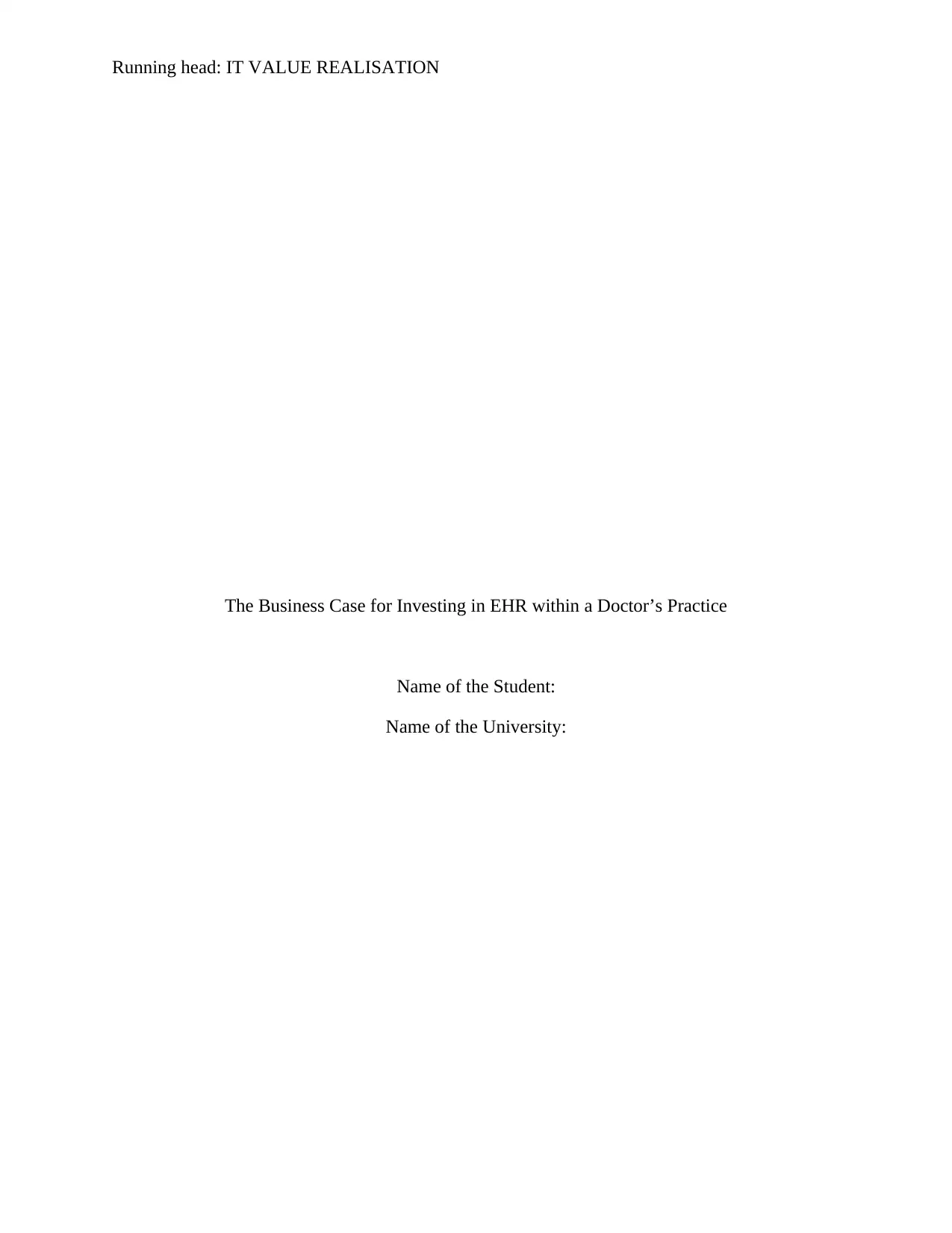
Running head: IT VALUE REALISATION
The Business Case for Investing in EHR within a Doctor’s Practice
Name of the Student:
Name of the University:
The Business Case for Investing in EHR within a Doctor’s Practice
Name of the Student:
Name of the University:
Paraphrase This Document
Need a fresh take? Get an instant paraphrase of this document with our AI Paraphraser
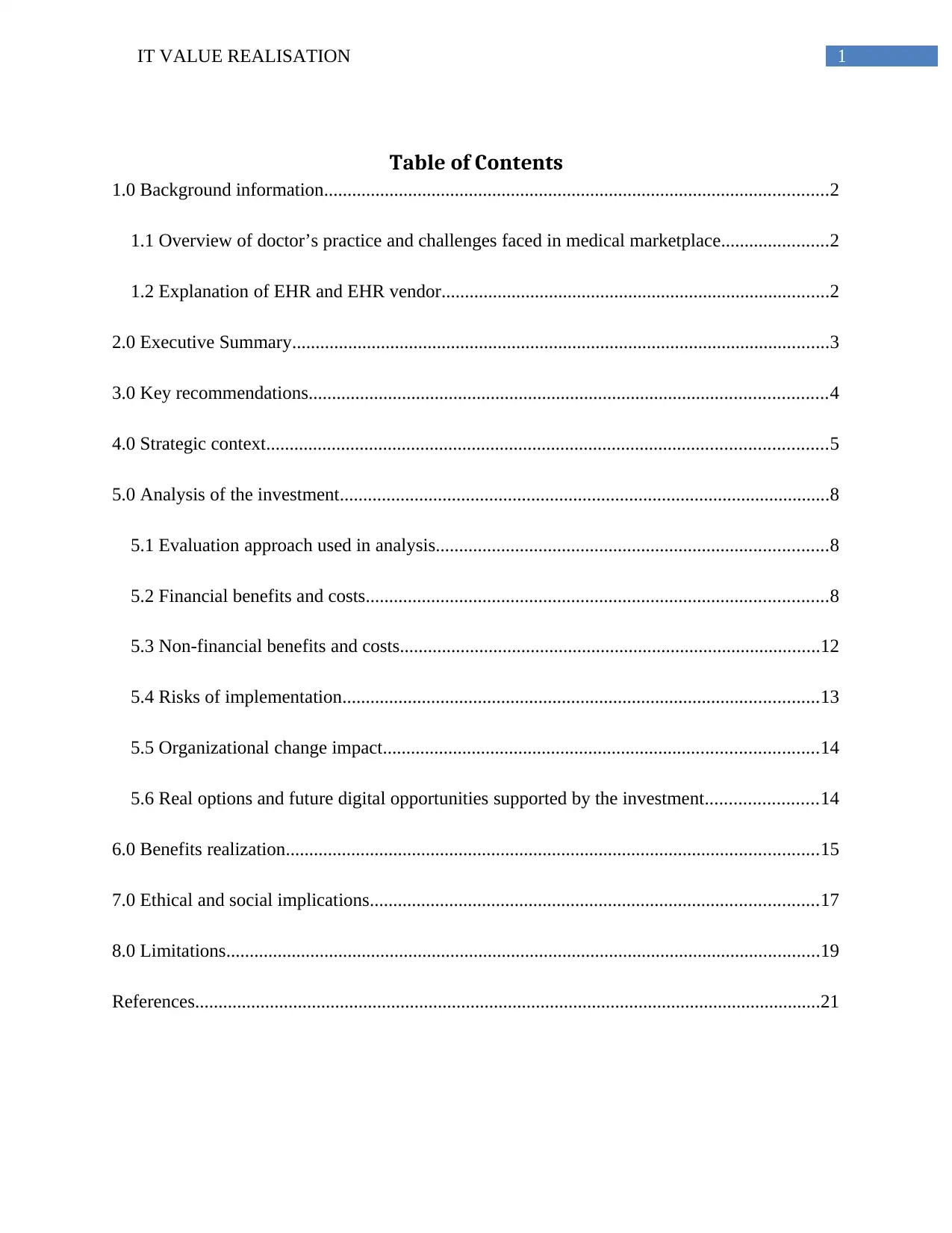
1IT VALUE REALISATION
Table of Contents
1.0 Background information............................................................................................................2
1.1 Overview of doctor’s practice and challenges faced in medical marketplace.......................2
1.2 Explanation of EHR and EHR vendor...................................................................................2
2.0 Executive Summary...................................................................................................................3
3.0 Key recommendations...............................................................................................................4
4.0 Strategic context........................................................................................................................5
5.0 Analysis of the investment.........................................................................................................8
5.1 Evaluation approach used in analysis....................................................................................8
5.2 Financial benefits and costs...................................................................................................8
5.3 Non-financial benefits and costs..........................................................................................12
5.4 Risks of implementation......................................................................................................13
5.5 Organizational change impact.............................................................................................14
5.6 Real options and future digital opportunities supported by the investment........................14
6.0 Benefits realization..................................................................................................................15
7.0 Ethical and social implications................................................................................................17
8.0 Limitations...............................................................................................................................19
References......................................................................................................................................21
Table of Contents
1.0 Background information............................................................................................................2
1.1 Overview of doctor’s practice and challenges faced in medical marketplace.......................2
1.2 Explanation of EHR and EHR vendor...................................................................................2
2.0 Executive Summary...................................................................................................................3
3.0 Key recommendations...............................................................................................................4
4.0 Strategic context........................................................................................................................5
5.0 Analysis of the investment.........................................................................................................8
5.1 Evaluation approach used in analysis....................................................................................8
5.2 Financial benefits and costs...................................................................................................8
5.3 Non-financial benefits and costs..........................................................................................12
5.4 Risks of implementation......................................................................................................13
5.5 Organizational change impact.............................................................................................14
5.6 Real options and future digital opportunities supported by the investment........................14
6.0 Benefits realization..................................................................................................................15
7.0 Ethical and social implications................................................................................................17
8.0 Limitations...............................................................................................................................19
References......................................................................................................................................21

2IT VALUE REALISATION
⊘ This is a preview!⊘
Do you want full access?
Subscribe today to unlock all pages.

Trusted by 1+ million students worldwide
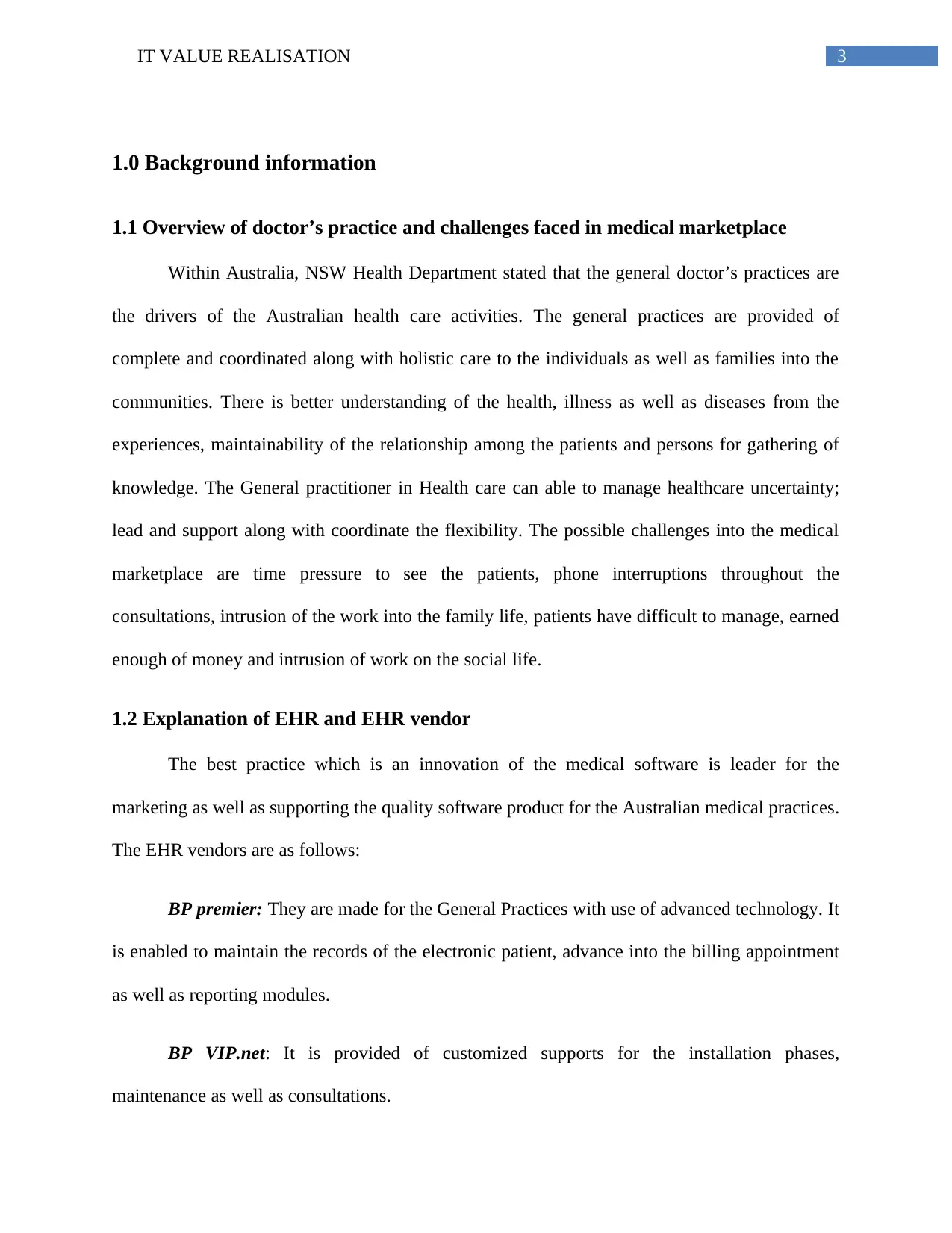
3IT VALUE REALISATION
1.0 Background information
1.1 Overview of doctor’s practice and challenges faced in medical marketplace
Within Australia, NSW Health Department stated that the general doctor’s practices are
the drivers of the Australian health care activities. The general practices are provided of
complete and coordinated along with holistic care to the individuals as well as families into the
communities. There is better understanding of the health, illness as well as diseases from the
experiences, maintainability of the relationship among the patients and persons for gathering of
knowledge. The General practitioner in Health care can able to manage healthcare uncertainty;
lead and support along with coordinate the flexibility. The possible challenges into the medical
marketplace are time pressure to see the patients, phone interruptions throughout the
consultations, intrusion of the work into the family life, patients have difficult to manage, earned
enough of money and intrusion of work on the social life.
1.2 Explanation of EHR and EHR vendor
The best practice which is an innovation of the medical software is leader for the
marketing as well as supporting the quality software product for the Australian medical practices.
The EHR vendors are as follows:
BP premier: They are made for the General Practices with use of advanced technology. It
is enabled to maintain the records of the electronic patient, advance into the billing appointment
as well as reporting modules.
BP VIP.net: It is provided of customized supports for the installation phases,
maintenance as well as consultations.
1.0 Background information
1.1 Overview of doctor’s practice and challenges faced in medical marketplace
Within Australia, NSW Health Department stated that the general doctor’s practices are
the drivers of the Australian health care activities. The general practices are provided of
complete and coordinated along with holistic care to the individuals as well as families into the
communities. There is better understanding of the health, illness as well as diseases from the
experiences, maintainability of the relationship among the patients and persons for gathering of
knowledge. The General practitioner in Health care can able to manage healthcare uncertainty;
lead and support along with coordinate the flexibility. The possible challenges into the medical
marketplace are time pressure to see the patients, phone interruptions throughout the
consultations, intrusion of the work into the family life, patients have difficult to manage, earned
enough of money and intrusion of work on the social life.
1.2 Explanation of EHR and EHR vendor
The best practice which is an innovation of the medical software is leader for the
marketing as well as supporting the quality software product for the Australian medical practices.
The EHR vendors are as follows:
BP premier: They are made for the General Practices with use of advanced technology. It
is enabled to maintain the records of the electronic patient, advance into the billing appointment
as well as reporting modules.
BP VIP.net: It is provided of customized supports for the installation phases,
maintenance as well as consultations.
Paraphrase This Document
Need a fresh take? Get an instant paraphrase of this document with our AI Paraphraser
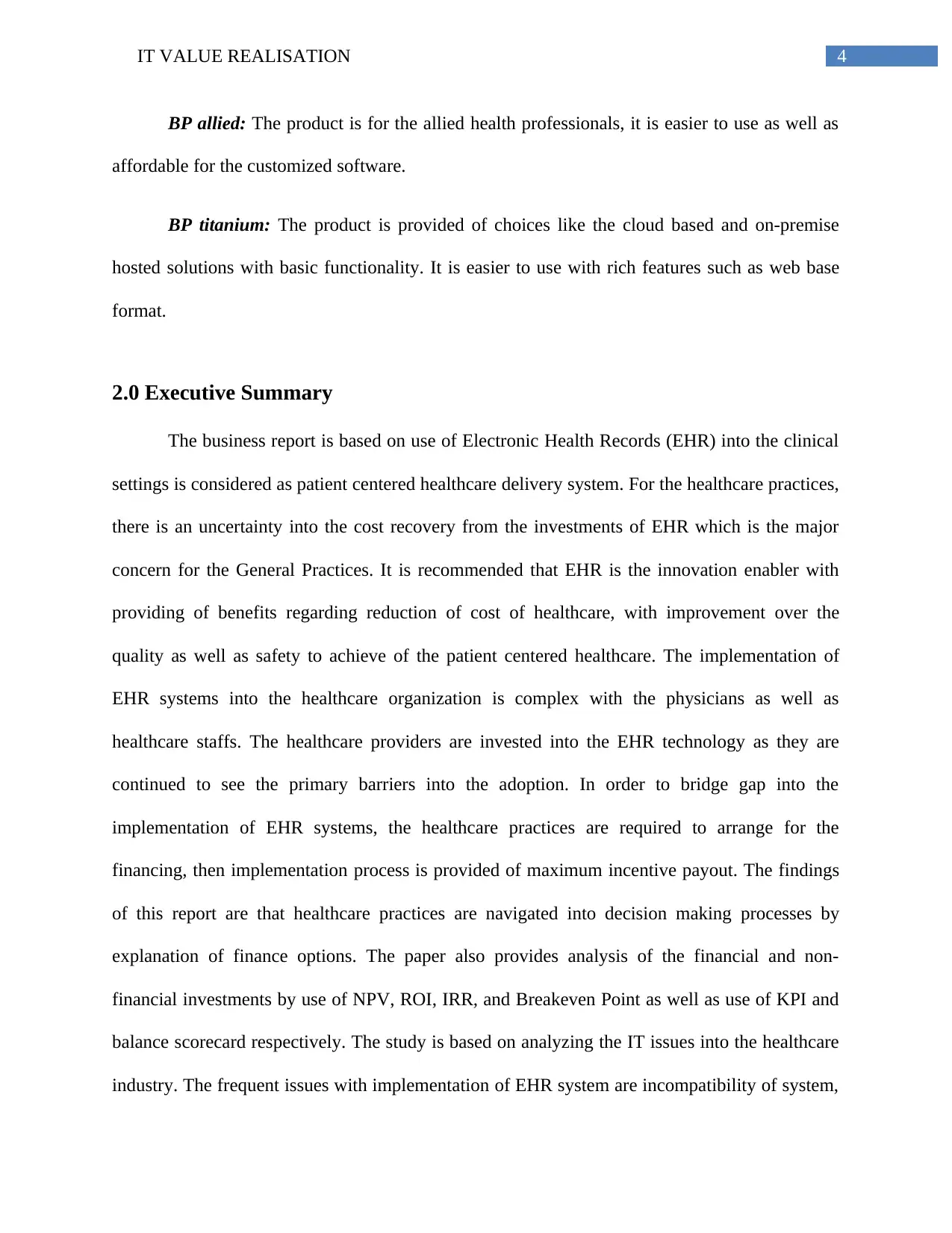
4IT VALUE REALISATION
BP allied: The product is for the allied health professionals, it is easier to use as well as
affordable for the customized software.
BP titanium: The product is provided of choices like the cloud based and on-premise
hosted solutions with basic functionality. It is easier to use with rich features such as web base
format.
2.0 Executive Summary
The business report is based on use of Electronic Health Records (EHR) into the clinical
settings is considered as patient centered healthcare delivery system. For the healthcare practices,
there is an uncertainty into the cost recovery from the investments of EHR which is the major
concern for the General Practices. It is recommended that EHR is the innovation enabler with
providing of benefits regarding reduction of cost of healthcare, with improvement over the
quality as well as safety to achieve of the patient centered healthcare. The implementation of
EHR systems into the healthcare organization is complex with the physicians as well as
healthcare staffs. The healthcare providers are invested into the EHR technology as they are
continued to see the primary barriers into the adoption. In order to bridge gap into the
implementation of EHR systems, the healthcare practices are required to arrange for the
financing, then implementation process is provided of maximum incentive payout. The findings
of this report are that healthcare practices are navigated into decision making processes by
explanation of finance options. The paper also provides analysis of the financial and non-
financial investments by use of NPV, ROI, IRR, and Breakeven Point as well as use of KPI and
balance scorecard respectively. The study is based on analyzing the IT issues into the healthcare
industry. The frequent issues with implementation of EHR system are incompatibility of system,
BP allied: The product is for the allied health professionals, it is easier to use as well as
affordable for the customized software.
BP titanium: The product is provided of choices like the cloud based and on-premise
hosted solutions with basic functionality. It is easier to use with rich features such as web base
format.
2.0 Executive Summary
The business report is based on use of Electronic Health Records (EHR) into the clinical
settings is considered as patient centered healthcare delivery system. For the healthcare practices,
there is an uncertainty into the cost recovery from the investments of EHR which is the major
concern for the General Practices. It is recommended that EHR is the innovation enabler with
providing of benefits regarding reduction of cost of healthcare, with improvement over the
quality as well as safety to achieve of the patient centered healthcare. The implementation of
EHR systems into the healthcare organization is complex with the physicians as well as
healthcare staffs. The healthcare providers are invested into the EHR technology as they are
continued to see the primary barriers into the adoption. In order to bridge gap into the
implementation of EHR systems, the healthcare practices are required to arrange for the
financing, then implementation process is provided of maximum incentive payout. The findings
of this report are that healthcare practices are navigated into decision making processes by
explanation of finance options. The paper also provides analysis of the financial and non-
financial investments by use of NPV, ROI, IRR, and Breakeven Point as well as use of KPI and
balance scorecard respectively. The study is based on analyzing the IT issues into the healthcare
industry. The frequent issues with implementation of EHR system are incompatibility of system,
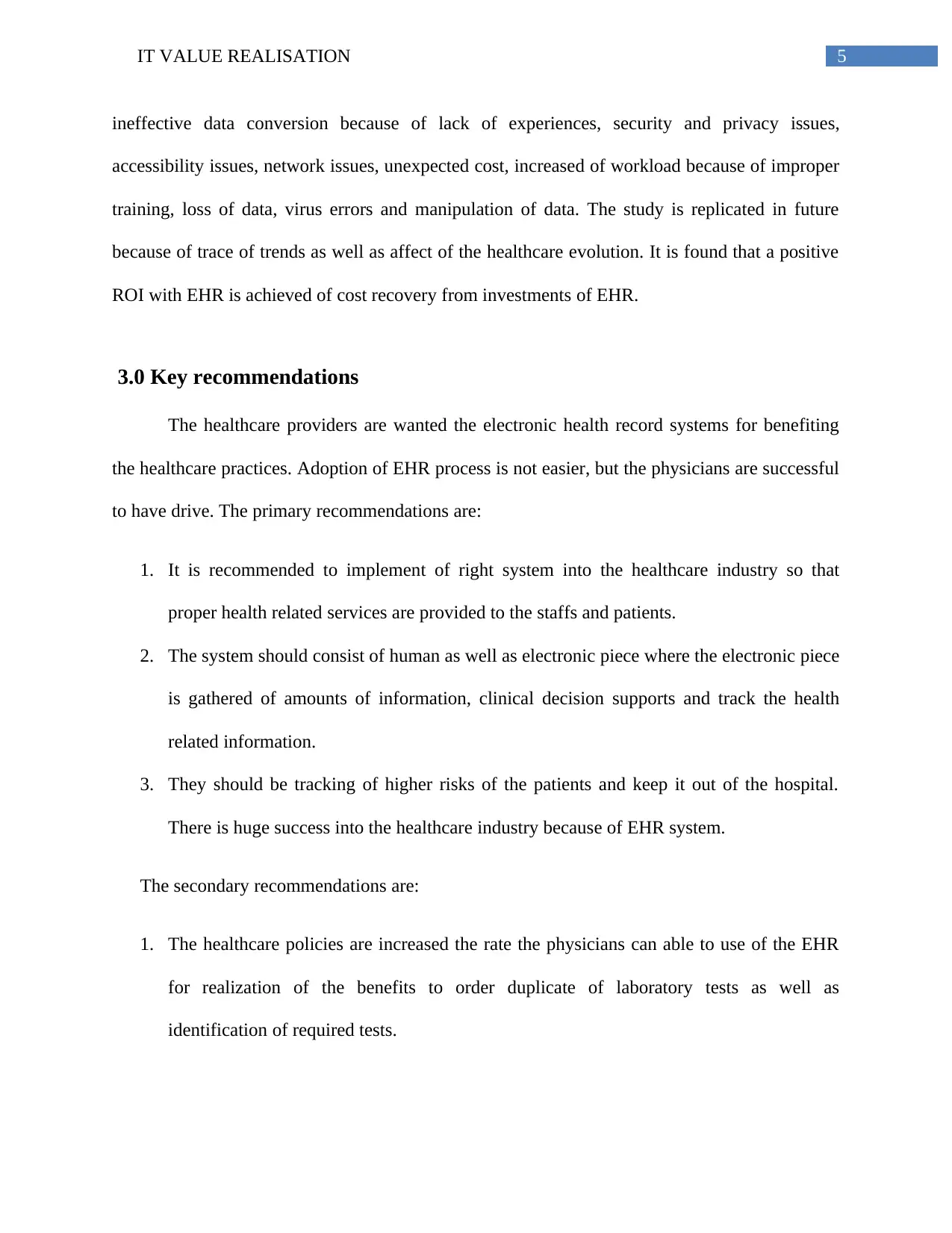
5IT VALUE REALISATION
ineffective data conversion because of lack of experiences, security and privacy issues,
accessibility issues, network issues, unexpected cost, increased of workload because of improper
training, loss of data, virus errors and manipulation of data. The study is replicated in future
because of trace of trends as well as affect of the healthcare evolution. It is found that a positive
ROI with EHR is achieved of cost recovery from investments of EHR.
3.0 Key recommendations
The healthcare providers are wanted the electronic health record systems for benefiting
the healthcare practices. Adoption of EHR process is not easier, but the physicians are successful
to have drive. The primary recommendations are:
1. It is recommended to implement of right system into the healthcare industry so that
proper health related services are provided to the staffs and patients.
2. The system should consist of human as well as electronic piece where the electronic piece
is gathered of amounts of information, clinical decision supports and track the health
related information.
3. They should be tracking of higher risks of the patients and keep it out of the hospital.
There is huge success into the healthcare industry because of EHR system.
The secondary recommendations are:
1. The healthcare policies are increased the rate the physicians can able to use of the EHR
for realization of the benefits to order duplicate of laboratory tests as well as
identification of required tests.
ineffective data conversion because of lack of experiences, security and privacy issues,
accessibility issues, network issues, unexpected cost, increased of workload because of improper
training, loss of data, virus errors and manipulation of data. The study is replicated in future
because of trace of trends as well as affect of the healthcare evolution. It is found that a positive
ROI with EHR is achieved of cost recovery from investments of EHR.
3.0 Key recommendations
The healthcare providers are wanted the electronic health record systems for benefiting
the healthcare practices. Adoption of EHR process is not easier, but the physicians are successful
to have drive. The primary recommendations are:
1. It is recommended to implement of right system into the healthcare industry so that
proper health related services are provided to the staffs and patients.
2. The system should consist of human as well as electronic piece where the electronic piece
is gathered of amounts of information, clinical decision supports and track the health
related information.
3. They should be tracking of higher risks of the patients and keep it out of the hospital.
There is huge success into the healthcare industry because of EHR system.
The secondary recommendations are:
1. The healthcare policies are increased the rate the physicians can able to use of the EHR
for realization of the benefits to order duplicate of laboratory tests as well as
identification of required tests.
⊘ This is a preview!⊘
Do you want full access?
Subscribe today to unlock all pages.

Trusted by 1+ million students worldwide
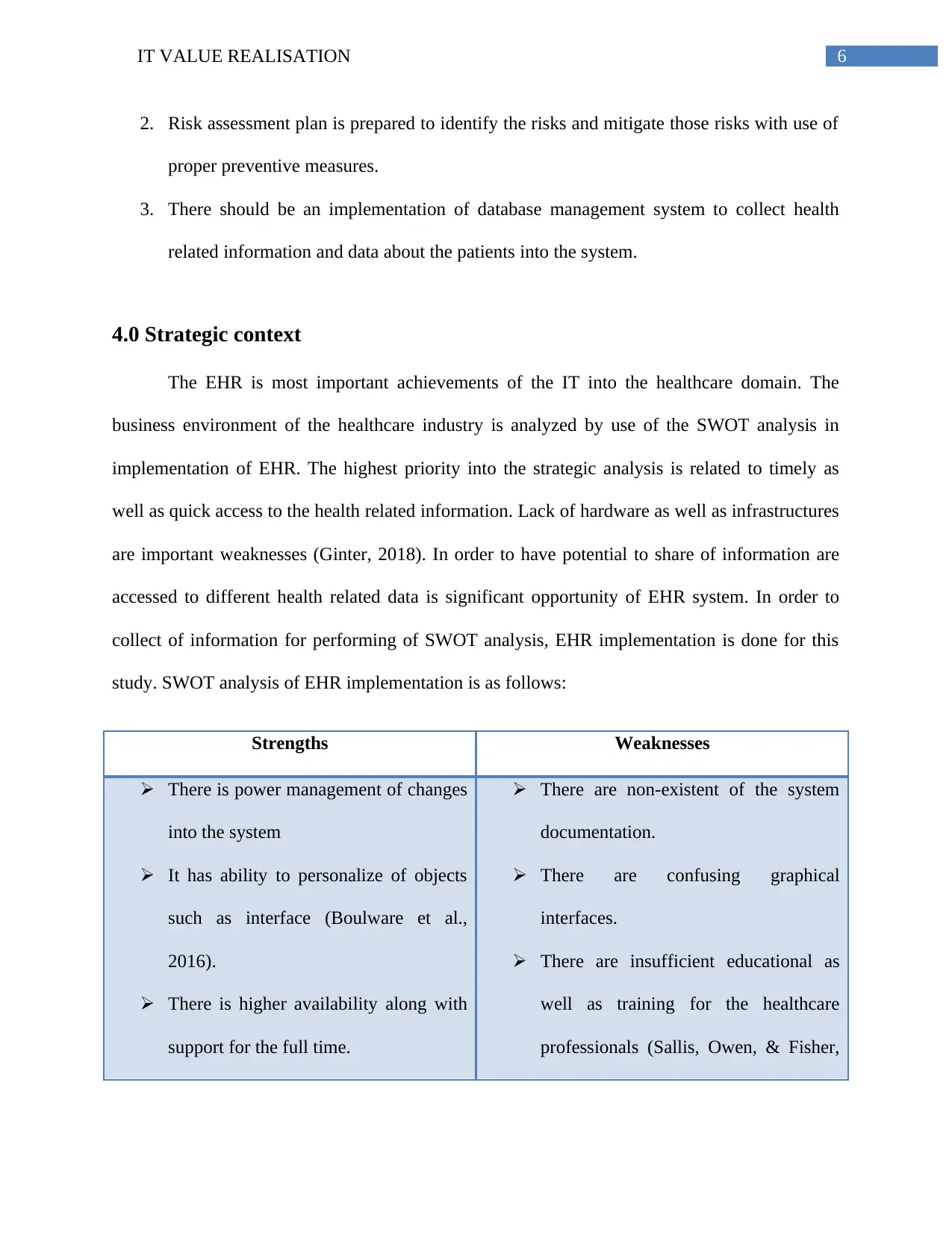
6IT VALUE REALISATION
2. Risk assessment plan is prepared to identify the risks and mitigate those risks with use of
proper preventive measures.
3. There should be an implementation of database management system to collect health
related information and data about the patients into the system.
4.0 Strategic context
The EHR is most important achievements of the IT into the healthcare domain. The
business environment of the healthcare industry is analyzed by use of the SWOT analysis in
implementation of EHR. The highest priority into the strategic analysis is related to timely as
well as quick access to the health related information. Lack of hardware as well as infrastructures
are important weaknesses (Ginter, 2018). In order to have potential to share of information are
accessed to different health related data is significant opportunity of EHR system. In order to
collect of information for performing of SWOT analysis, EHR implementation is done for this
study. SWOT analysis of EHR implementation is as follows:
Strengths Weaknesses
There is power management of changes
into the system
It has ability to personalize of objects
such as interface (Boulware et al.,
2016).
There is higher availability along with
support for the full time.
There are non-existent of the system
documentation.
There are confusing graphical
interfaces.
There are insufficient educational as
well as training for the healthcare
professionals (Sallis, Owen, & Fisher,
2. Risk assessment plan is prepared to identify the risks and mitigate those risks with use of
proper preventive measures.
3. There should be an implementation of database management system to collect health
related information and data about the patients into the system.
4.0 Strategic context
The EHR is most important achievements of the IT into the healthcare domain. The
business environment of the healthcare industry is analyzed by use of the SWOT analysis in
implementation of EHR. The highest priority into the strategic analysis is related to timely as
well as quick access to the health related information. Lack of hardware as well as infrastructures
are important weaknesses (Ginter, 2018). In order to have potential to share of information are
accessed to different health related data is significant opportunity of EHR system. In order to
collect of information for performing of SWOT analysis, EHR implementation is done for this
study. SWOT analysis of EHR implementation is as follows:
Strengths Weaknesses
There is power management of changes
into the system
It has ability to personalize of objects
such as interface (Boulware et al.,
2016).
There is higher availability along with
support for the full time.
There are non-existent of the system
documentation.
There are confusing graphical
interfaces.
There are insufficient educational as
well as training for the healthcare
professionals (Sallis, Owen, & Fisher,
Paraphrase This Document
Need a fresh take? Get an instant paraphrase of this document with our AI Paraphraser
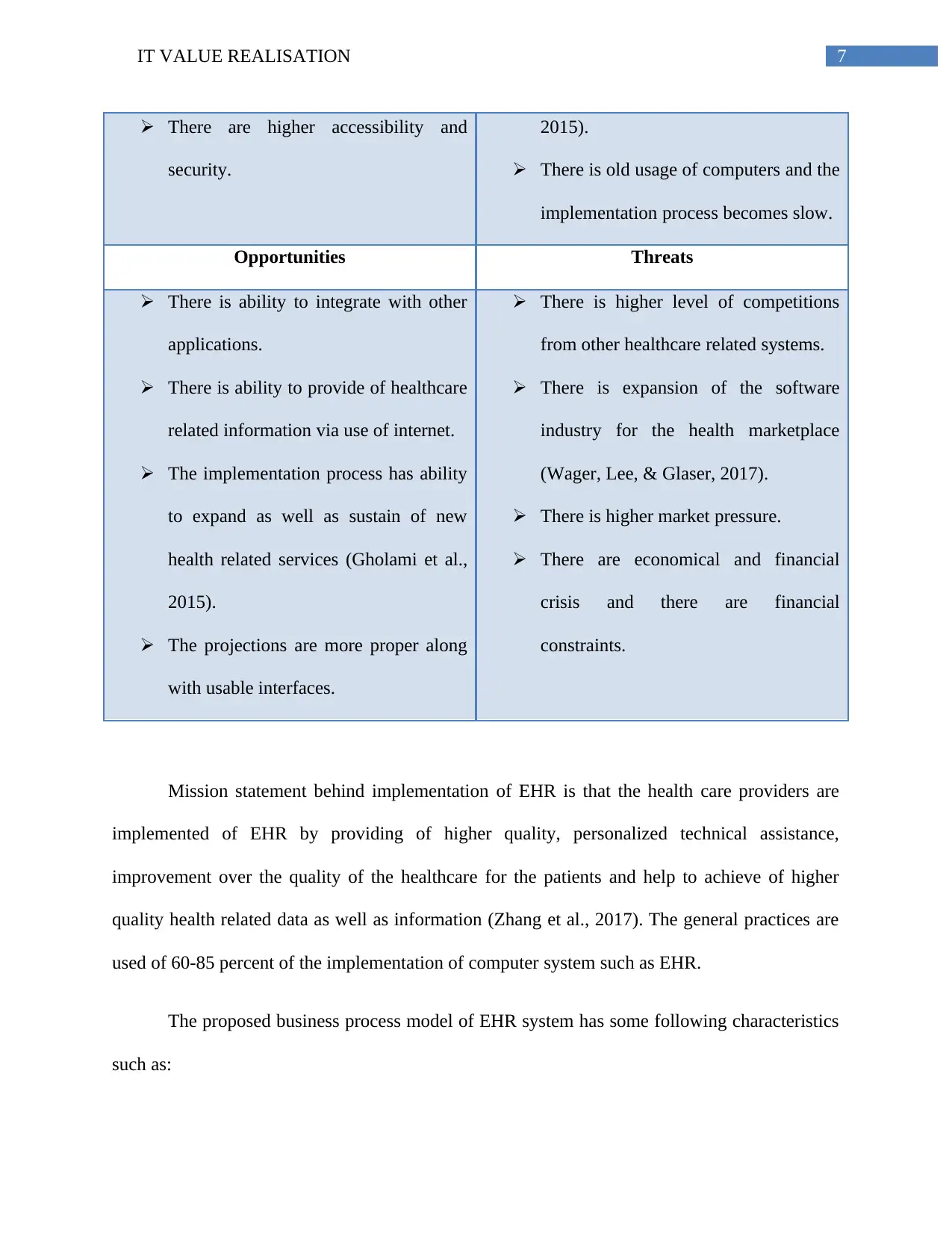
7IT VALUE REALISATION
There are higher accessibility and
security.
2015).
There is old usage of computers and the
implementation process becomes slow.
Opportunities Threats
There is ability to integrate with other
applications.
There is ability to provide of healthcare
related information via use of internet.
The implementation process has ability
to expand as well as sustain of new
health related services (Gholami et al.,
2015).
The projections are more proper along
with usable interfaces.
There is higher level of competitions
from other healthcare related systems.
There is expansion of the software
industry for the health marketplace
(Wager, Lee, & Glaser, 2017).
There is higher market pressure.
There are economical and financial
crisis and there are financial
constraints.
Mission statement behind implementation of EHR is that the health care providers are
implemented of EHR by providing of higher quality, personalized technical assistance,
improvement over the quality of the healthcare for the patients and help to achieve of higher
quality health related data as well as information (Zhang et al., 2017). The general practices are
used of 60-85 percent of the implementation of computer system such as EHR.
The proposed business process model of EHR system has some following characteristics
such as:
There are higher accessibility and
security.
2015).
There is old usage of computers and the
implementation process becomes slow.
Opportunities Threats
There is ability to integrate with other
applications.
There is ability to provide of healthcare
related information via use of internet.
The implementation process has ability
to expand as well as sustain of new
health related services (Gholami et al.,
2015).
The projections are more proper along
with usable interfaces.
There is higher level of competitions
from other healthcare related systems.
There is expansion of the software
industry for the health marketplace
(Wager, Lee, & Glaser, 2017).
There is higher market pressure.
There are economical and financial
crisis and there are financial
constraints.
Mission statement behind implementation of EHR is that the health care providers are
implemented of EHR by providing of higher quality, personalized technical assistance,
improvement over the quality of the healthcare for the patients and help to achieve of higher
quality health related data as well as information (Zhang et al., 2017). The general practices are
used of 60-85 percent of the implementation of computer system such as EHR.
The proposed business process model of EHR system has some following characteristics
such as:
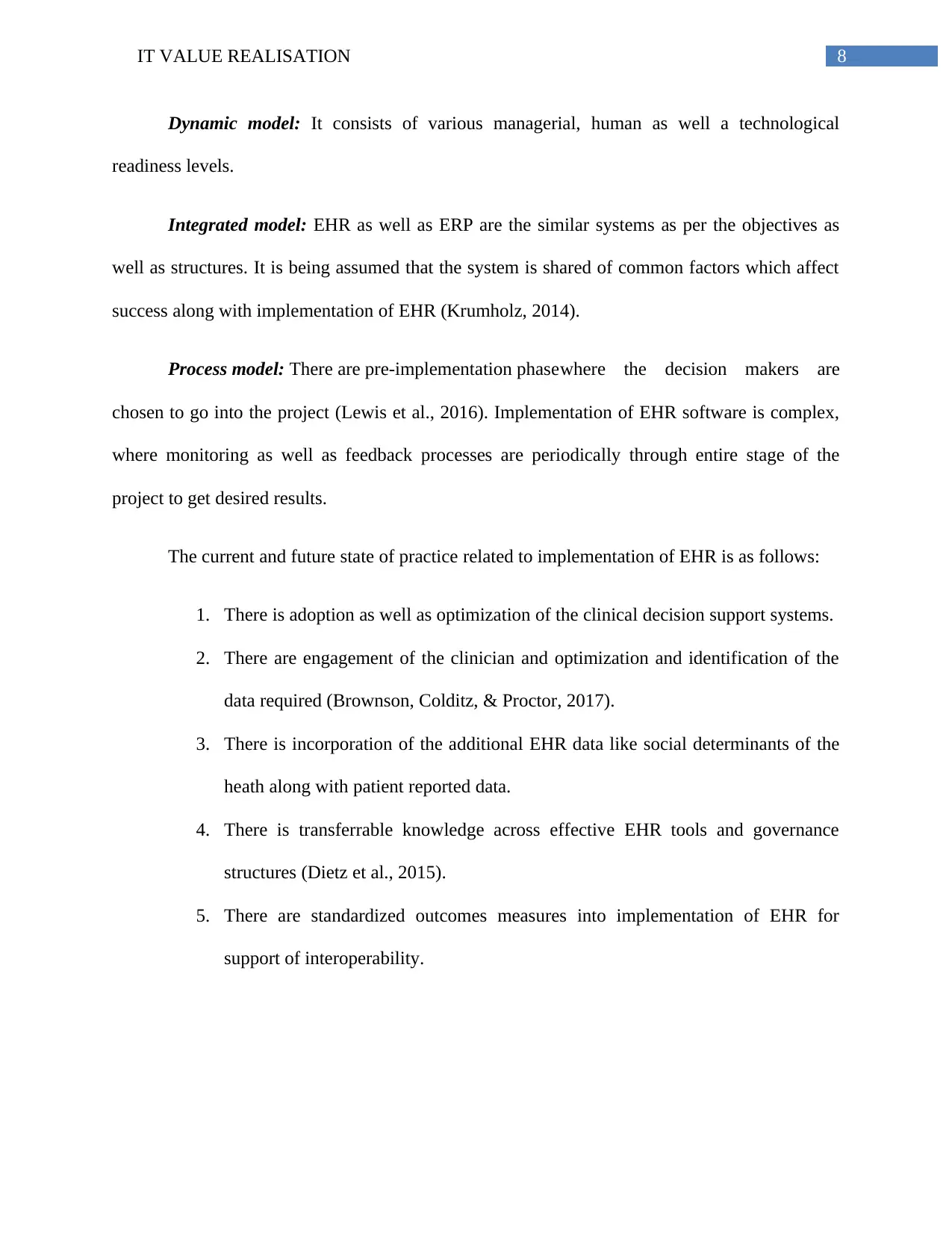
8IT VALUE REALISATION
Dynamic model: It consists of various managerial, human as well a technological
readiness levels.
Integrated model: EHR as well as ERP are the similar systems as per the objectives as
well as structures. It is being assumed that the system is shared of common factors which affect
success along with implementation of EHR (Krumholz, 2014).
Process model: There are pre-implementation phasewhere the decision makers are
chosen to go into the project (Lewis et al., 2016). Implementation of EHR software is complex,
where monitoring as well as feedback processes are periodically through entire stage of the
project to get desired results.
The current and future state of practice related to implementation of EHR is as follows:
1. There is adoption as well as optimization of the clinical decision support systems.
2. There are engagement of the clinician and optimization and identification of the
data required (Brownson, Colditz, & Proctor, 2017).
3. There is incorporation of the additional EHR data like social determinants of the
heath along with patient reported data.
4. There is transferrable knowledge across effective EHR tools and governance
structures (Dietz et al., 2015).
5. There are standardized outcomes measures into implementation of EHR for
support of interoperability.
Dynamic model: It consists of various managerial, human as well a technological
readiness levels.
Integrated model: EHR as well as ERP are the similar systems as per the objectives as
well as structures. It is being assumed that the system is shared of common factors which affect
success along with implementation of EHR (Krumholz, 2014).
Process model: There are pre-implementation phasewhere the decision makers are
chosen to go into the project (Lewis et al., 2016). Implementation of EHR software is complex,
where monitoring as well as feedback processes are periodically through entire stage of the
project to get desired results.
The current and future state of practice related to implementation of EHR is as follows:
1. There is adoption as well as optimization of the clinical decision support systems.
2. There are engagement of the clinician and optimization and identification of the
data required (Brownson, Colditz, & Proctor, 2017).
3. There is incorporation of the additional EHR data like social determinants of the
heath along with patient reported data.
4. There is transferrable knowledge across effective EHR tools and governance
structures (Dietz et al., 2015).
5. There are standardized outcomes measures into implementation of EHR for
support of interoperability.
⊘ This is a preview!⊘
Do you want full access?
Subscribe today to unlock all pages.

Trusted by 1+ million students worldwide
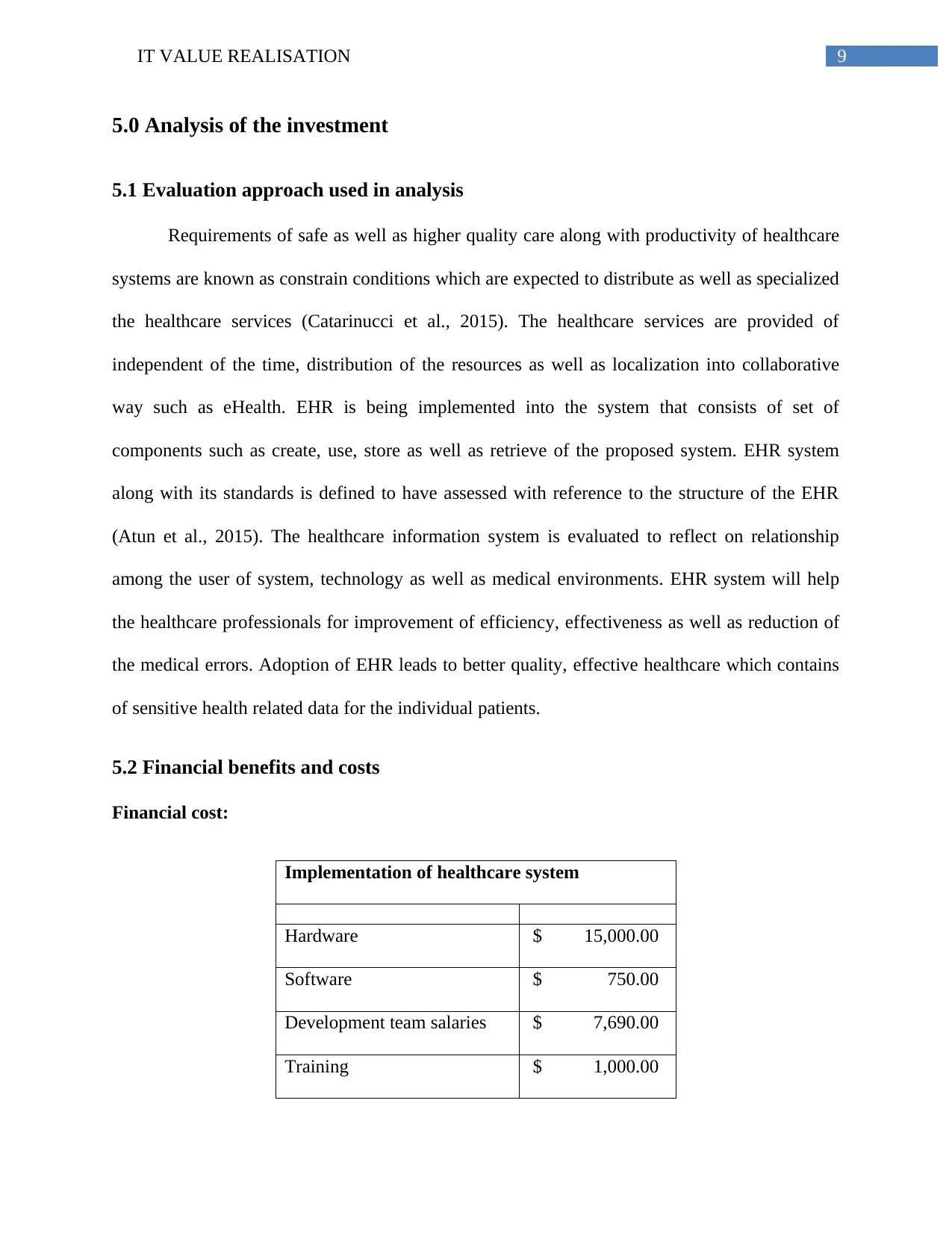
9IT VALUE REALISATION
5.0 Analysis of the investment
5.1 Evaluation approach used in analysis
Requirements of safe as well as higher quality care along with productivity of healthcare
systems are known as constrain conditions which are expected to distribute as well as specialized
the healthcare services (Catarinucci et al., 2015). The healthcare services are provided of
independent of the time, distribution of the resources as well as localization into collaborative
way such as eHealth. EHR is being implemented into the system that consists of set of
components such as create, use, store as well as retrieve of the proposed system. EHR system
along with its standards is defined to have assessed with reference to the structure of the EHR
(Atun et al., 2015). The healthcare information system is evaluated to reflect on relationship
among the user of system, technology as well as medical environments. EHR system will help
the healthcare professionals for improvement of efficiency, effectiveness as well as reduction of
the medical errors. Adoption of EHR leads to better quality, effective healthcare which contains
of sensitive health related data for the individual patients.
5.2 Financial benefits and costs
Financial cost:
Implementation of healthcare system
Hardware $ 15,000.00
Software $ 750.00
Development team salaries $ 7,690.00
Training $ 1,000.00
5.0 Analysis of the investment
5.1 Evaluation approach used in analysis
Requirements of safe as well as higher quality care along with productivity of healthcare
systems are known as constrain conditions which are expected to distribute as well as specialized
the healthcare services (Catarinucci et al., 2015). The healthcare services are provided of
independent of the time, distribution of the resources as well as localization into collaborative
way such as eHealth. EHR is being implemented into the system that consists of set of
components such as create, use, store as well as retrieve of the proposed system. EHR system
along with its standards is defined to have assessed with reference to the structure of the EHR
(Atun et al., 2015). The healthcare information system is evaluated to reflect on relationship
among the user of system, technology as well as medical environments. EHR system will help
the healthcare professionals for improvement of efficiency, effectiveness as well as reduction of
the medical errors. Adoption of EHR leads to better quality, effective healthcare which contains
of sensitive health related data for the individual patients.
5.2 Financial benefits and costs
Financial cost:
Implementation of healthcare system
Hardware $ 15,000.00
Software $ 750.00
Development team salaries $ 7,690.00
Training $ 1,000.00
Paraphrase This Document
Need a fresh take? Get an instant paraphrase of this document with our AI Paraphraser
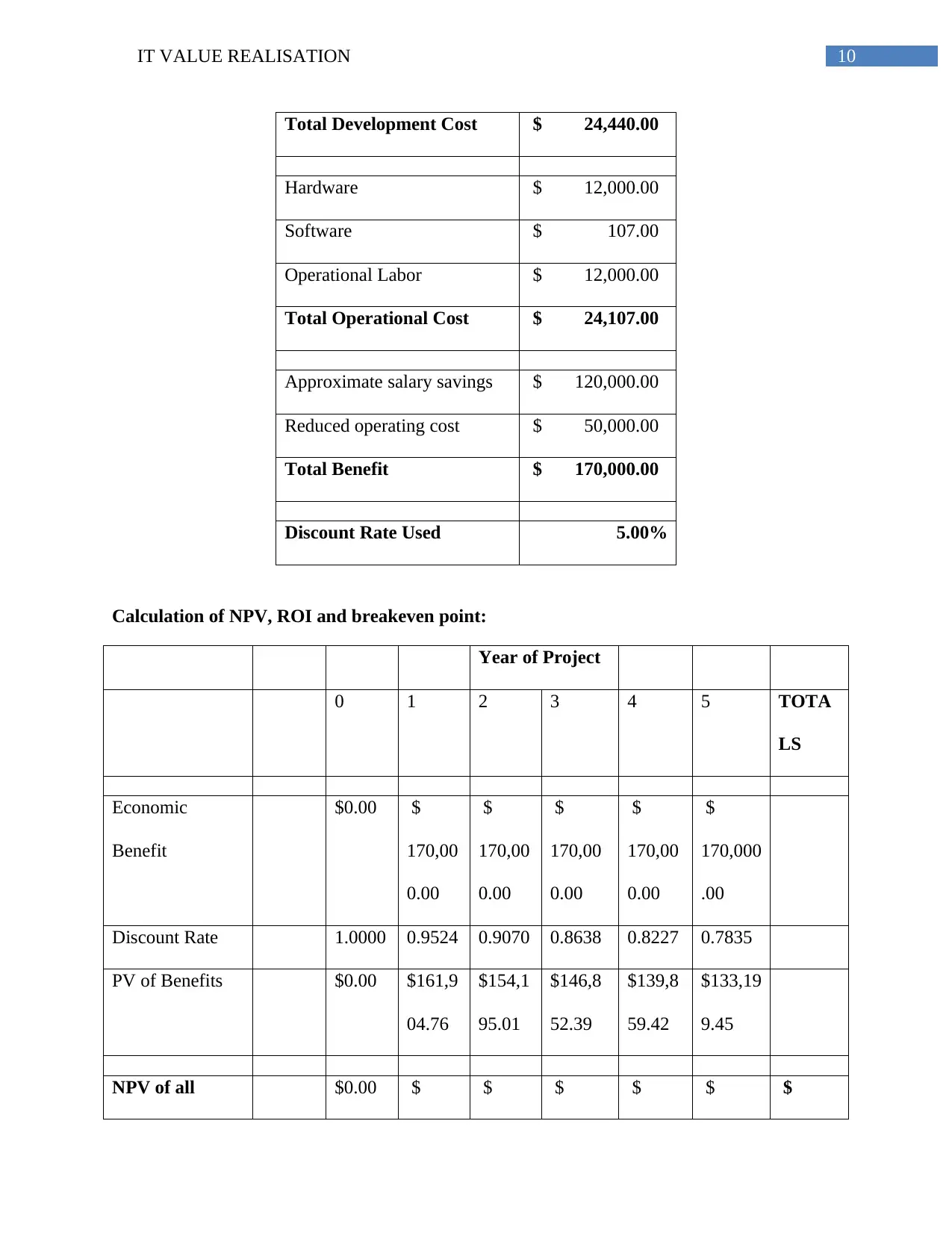
10IT VALUE REALISATION
Total Development Cost $ 24,440.00
Hardware $ 12,000.00
Software $ 107.00
Operational Labor $ 12,000.00
Total Operational Cost $ 24,107.00
Approximate salary savings $ 120,000.00
Reduced operating cost $ 50,000.00
Total Benefit $ 170,000.00
Discount Rate Used 5.00%
Calculation of NPV, ROI and breakeven point:
Year of Project
0 1 2 3 4 5 TOTA
LS
Economic
Benefit
$0.00 $
170,00
0.00
$
170,00
0.00
$
170,00
0.00
$
170,00
0.00
$
170,000
.00
Discount Rate 1.0000 0.9524 0.9070 0.8638 0.8227 0.7835
PV of Benefits $0.00 $161,9
04.76
$154,1
95.01
$146,8
52.39
$139,8
59.42
$133,19
9.45
NPV of all $0.00 $ $ $ $ $ $
Total Development Cost $ 24,440.00
Hardware $ 12,000.00
Software $ 107.00
Operational Labor $ 12,000.00
Total Operational Cost $ 24,107.00
Approximate salary savings $ 120,000.00
Reduced operating cost $ 50,000.00
Total Benefit $ 170,000.00
Discount Rate Used 5.00%
Calculation of NPV, ROI and breakeven point:
Year of Project
0 1 2 3 4 5 TOTA
LS
Economic
Benefit
$0.00 $
170,00
0.00
$
170,00
0.00
$
170,00
0.00
$
170,00
0.00
$
170,000
.00
Discount Rate 1.0000 0.9524 0.9070 0.8638 0.8227 0.7835
PV of Benefits $0.00 $161,9
04.76
$154,1
95.01
$146,8
52.39
$139,8
59.42
$133,19
9.45
NPV of all $0.00 $ $ $ $ $ $
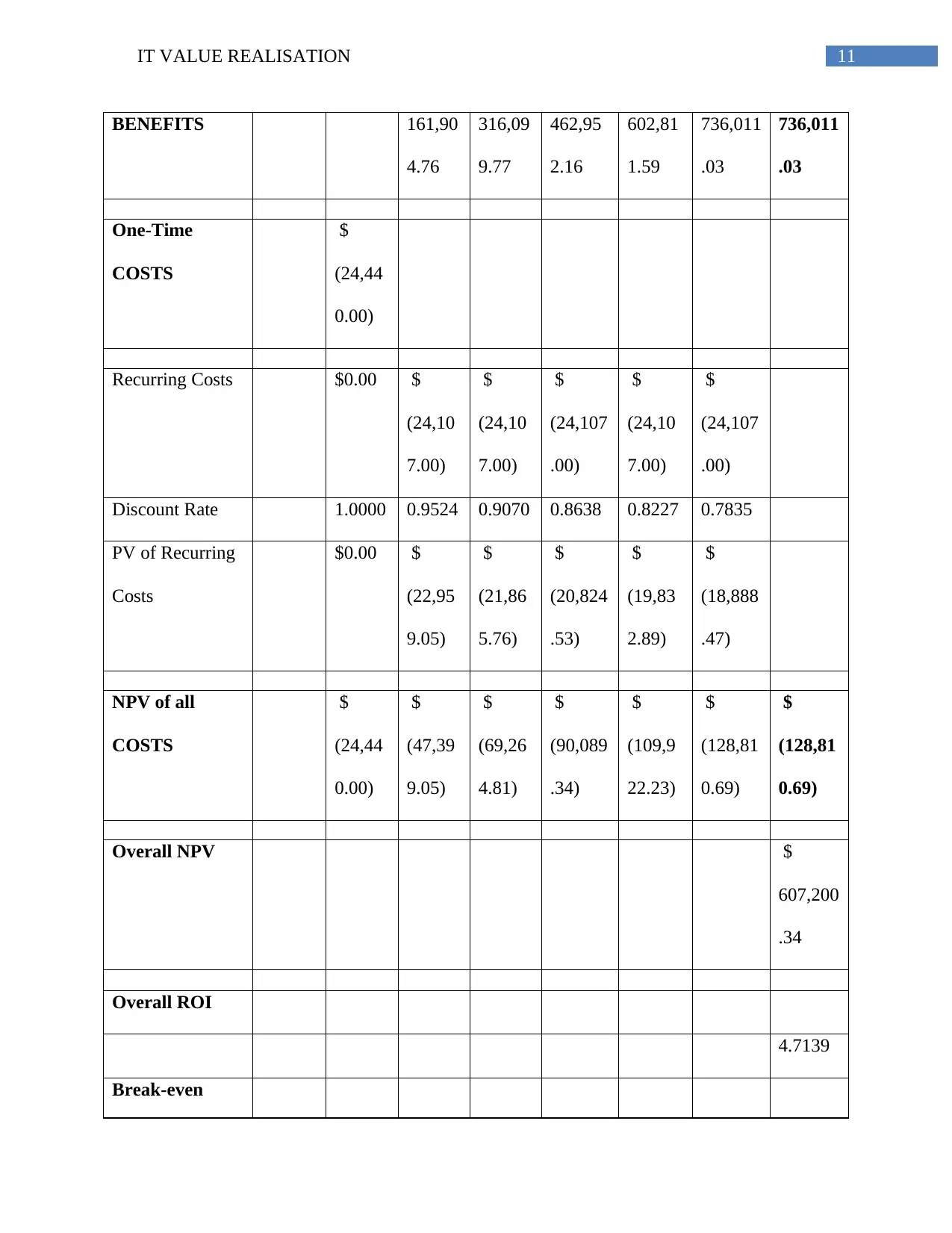
11IT VALUE REALISATION
BENEFITS 161,90
4.76
316,09
9.77
462,95
2.16
602,81
1.59
736,011
.03
736,011
.03
One-Time
COSTS
$
(24,44
0.00)
Recurring Costs $0.00 $
(24,10
7.00)
$
(24,10
7.00)
$
(24,107
.00)
$
(24,10
7.00)
$
(24,107
.00)
Discount Rate 1.0000 0.9524 0.9070 0.8638 0.8227 0.7835
PV of Recurring
Costs
$0.00 $
(22,95
9.05)
$
(21,86
5.76)
$
(20,824
.53)
$
(19,83
2.89)
$
(18,888
.47)
NPV of all
COSTS
$
(24,44
0.00)
$
(47,39
9.05)
$
(69,26
4.81)
$
(90,089
.34)
$
(109,9
22.23)
$
(128,81
0.69)
$
(128,81
0.69)
Overall NPV $
607,200
.34
Overall ROI
4.7139
Break-even
BENEFITS 161,90
4.76
316,09
9.77
462,95
2.16
602,81
1.59
736,011
.03
736,011
.03
One-Time
COSTS
$
(24,44
0.00)
Recurring Costs $0.00 $
(24,10
7.00)
$
(24,10
7.00)
$
(24,107
.00)
$
(24,10
7.00)
$
(24,107
.00)
Discount Rate 1.0000 0.9524 0.9070 0.8638 0.8227 0.7835
PV of Recurring
Costs
$0.00 $
(22,95
9.05)
$
(21,86
5.76)
$
(20,824
.53)
$
(19,83
2.89)
$
(18,888
.47)
NPV of all
COSTS
$
(24,44
0.00)
$
(47,39
9.05)
$
(69,26
4.81)
$
(90,089
.34)
$
(109,9
22.23)
$
(128,81
0.69)
$
(128,81
0.69)
Overall NPV $
607,200
.34
Overall ROI
4.7139
Break-even
⊘ This is a preview!⊘
Do you want full access?
Subscribe today to unlock all pages.

Trusted by 1+ million students worldwide
1 out of 24
Related Documents
Your All-in-One AI-Powered Toolkit for Academic Success.
+13062052269
info@desklib.com
Available 24*7 on WhatsApp / Email
![[object Object]](/_next/static/media/star-bottom.7253800d.svg)
Unlock your academic potential
Copyright © 2020–2025 A2Z Services. All Rights Reserved. Developed and managed by ZUCOL.





